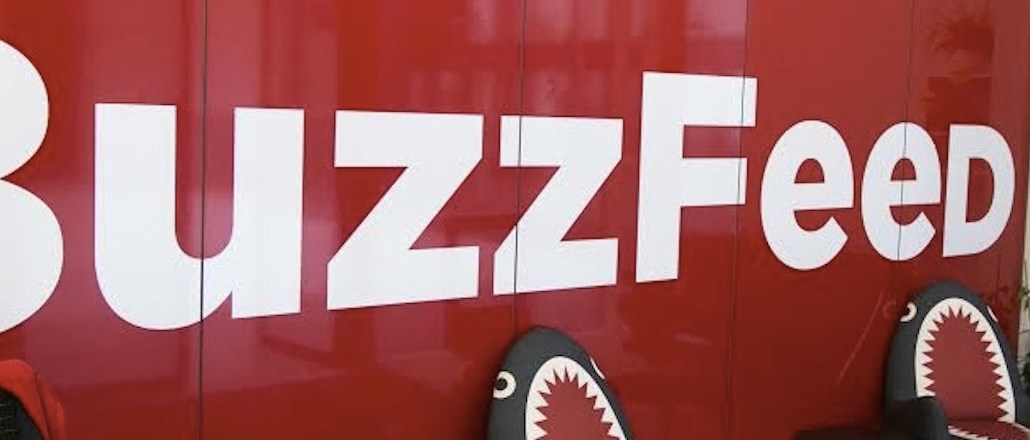
BuzzFeed’s shift to video is taking hold in its U.K. operations. The digital media company is doubling the size of its London office so it can house two new studios with a particular focus on sponsor video.
The goal: to bring all video production made on behalf of U.K. advertisers in-house. Previously, the set-up has involved a lot of the video production and editing handled in the Los Angeles or New York offices. From early next year, all work will be done from the U.K., which will speed up production times and lower its overall production costs, according to newly appointed sales chief for Europe Brant McLean, who was formerly the svp of brand strategy for the Central and South regions in the U.S.
McLean is filling the hole left by the departure of general manager for Europe Kate Burns. His team is currently around 20 people on the sales side, with 13 more positions open currently. All told, BuzzFeed now has 113 employees in London, with 80 producing content for both news and entertainment.
McLean had his first day in the U.K. Monday, where he appeared at BuzzFeed’s IAB Upfronts in London. Speaking to Digiday after his speech, McLean said that details on final headcount are yet to be determined but that BuzzFeed’s “doubling down” on its U.K. investment is a sign that there is further untapped commercial opportunity in Britain. He said the company has already seen U.K. revenue grow 50 percent year-over-year, although he wouldn’t say from what baseline. Agencies put the entry price for BuzzFeed campaigns in the U.K. at around the £50,000 ($61,000) mark. BuzzFeed has said that it has made its biggest deals to date in the U.K. in the last few months, which it specifically attributes to video.
“The U.K. team is really hitting its stride, and the opportunities are endless. It reminds me of the early BuzzFeed days,” said McLean. “We’ll no longer be relying on LA or New York to produce the content, so we’ll have new capabilities to leverage for brands. That’ll lower overall costs and speed up the production timeline, which is what everyone is asking for.”
Ad position: web_incontent_pos1
The U.K. was the first international market for BuzzFeed, launching in May 2013. BuzzFeed has since expanded to other markets, including Japan and Germany.
BuzzFeed, along with other digital media companies, is shifting more of its focus to video. CEO Jonah Peretti in August said the company would split into entertainment and news divisions — with video playing a big role across all BuzzFeed outlets. In the U.K., both news and entertainment report to former Guardian editor Janine Gibson, who is editor-in-chief for BuzzFeed U.K.
“Speeding up production by bringing two branded studios to the U.K. will potentially have a huge impact, especially as most clients work to super-tight deadlines,” said Essence partnerships and emerging media director Liam Pook. “Being able to brief, review proposals and feedback in a shorter period of time will strengthen BuzzFeed’s position alongside their competitors, who may have longer lead times.”
Ad position: web_incontent_pos2
This time last year, BuzzFeed announced its first U.K. brand video product for coffee chain Costa. It has since done video campaigns with Baileys, Barclays and Czech automaker Skoda, but now it wants to really scale it. It has also produced content for its food video brand Tasty, known as Proper Tasty in the U.K., which runs on Facebook, YouTube, Pinterest and Instagram, and for which it claimed 2.6 billion video views on Facebook alone in the last year. Tasty has six international channels.
Tom Dunn, head of futures at media agency Maxus, said BuzzFeed’s promise to evolve beyond its reputation as a popular site for listicles and polls was met with cynicism from agencies this time last year. “The industry didn’t expect them to do it, they were known for great cat videos,” he said. “But actually, they’ve managed to branch out into more serious areas of news that are more thoughtful and insightful.”
He’s referring to the investigative reporting team that BuzzFeed has built in the last year. In that time, the publisher has broken some major stories, like tennis match fixing, and has also hosted a European Referendum debate exclusively on Facebook Live, as it works hard to shed its reputation as a site just for popular listicles and viral content. It now claims it has the only reporter dedicated to covering LGBT matters, which gives it an additional edge.
And yet, BuzzFeed’s way of working with advertisers, has been challenging for some agencies, not least because the majority of BuzzFeed’s audience is found on platforms, not BuzzFeed’s own site. (According to comScore, BuzzFeed has 12 million monthly unique visitors in the U.K.)
“That’s quite a fragmented way of working, and media agencies have had to adapt to that and the idea that you can’t use a single creative across everything. But Snapchat and other platforms now require that also, so it’s probably helped prepare for that,” he added. “I welcome any plans to increase investment here because it means more local content. There are times when U.S. humor doesn’t always translate well here despite being English speaking.”
More in Media

NewFronts Briefing: Samsung, Condé Nast, Roku focus presentations on new ad formats and category-specific inventory
Day two of IAB’s NewFronts featured presentations from Samsung, Condé Nast and Roku, highlighting new partnerships, ad formats and inventory, as well as new AI capabilities.

The Athletic to raise ad prices as it paces to hit 3 million newsletter subscribers
The New York Times’ sports site The Athletic is about to hit 3 million total newsletter subscribers. It plans to raise ad prices as as a result of this nearly 20% year over year increase.

NewFronts Briefing: Google, Vizio and news publishers pitch marketers with new ad offerings and range of content categories
Day one of the 2024 IAB NewFronts featured presentations from Google and Vizio, as well as a spotlight on news publishers.
Ad position: web_bfu